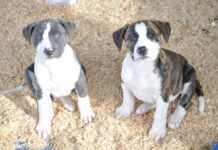I have a friend whose dogs are currently being terrorized by a band of aggressive turkeys in her neighborhood. Plus, her yard is not fenced, so the turkeys who wander down the block often take detours through her yard. They are not only large and noisy and numerous, they advance rather than retreat when her dogs approach them — to the point that her dogs no longer want to go outside in their own yard. And quiver when they look out the windows and see the large birds foraging in the shrubbery.
I’m dying to go over there and visit, because chasing turkeys is one of Otto’s E-ticket activities. He likes chasing any small animal when he has permission, but turkeys top the list. He seems to recognize the fruitlessness of chasing things like squirrels, so he doesn’t get too excited about it. But turkeys take to the air with a great loud flapping of wings and slowly, ponderously, as if those big bodies won’t be able to get aloft in time. It’s stimulating and hope-inspiring.
He gets excited about chasing strange cats out of our yard, too — that’s high up on the “top 10 Otto favorites” list – but he will also stop chasing and return to me on cue, at least 90 percent of the time. It took a LOT of work to install that “stop chasing and return” skill. I used the “Premack Principle” to help build that very useful behavior. (The Premack Principle is when you use a high-probability behavior to reinforce a lower probability one. In this case, it meant allowing him to chase a squirrel — or the neighbor’s cat — out of our yard after he’s seen it and come to me anyway. Of course, I use it only when the animal used for the reward has zero chance of getting caught. For more about Premack, see “Beyond Basic Dog Training,” WDJ April 2004 and “On-Leash Training Blossoms into Off-Leash Reliability,” March 2011.
Marauding turkeys would never be a problem for Otto, but there is another small animal that could ruin his day: skunks. He’s one of the few dogs I know who actually learned a lesson about skunks after being sprayed twice. When he sees or smells a skunk now, he whines and licks his lips and watches the skunk restlessly, but he won’t approach it. I’m thrilled with that. My sister’s Jack Russell Terriers could never be taught to resist, no matter how many times they were sprayed in the face. (Once, famously, when my sister had a sitter watching her dogs and her house, and the dogs had use of a dog door, and they probably had 10 or so hours to try to rub the skunk spray off of themselves, using her bed and sofa and rugs.)
Raccoons are another big threat to dogs (especially small dogs), in every sort of environment – rural, urban, and suburban. Mary Straus’s articles in the July and September issues of WDJ, chronicle some of the problems they can spell for dog owners. My sister’s JRTs saved her Chihuahua from being eaten by a raccoon once (and it was that clueless Chi’s second raccoon attack!).
WDJ’s Training Editor Pat Miller has long complained about one of her dogs, who can’t messing with (and keeps getting torn up during altercations with) groundhogs. I just couldn’t imagine such a thing, until I saw my first groundhog, while in Toronto recently (we don’t have them in California). Dang! Those things get big! And they just sort of SIT there, daring a dog to come at them. They must have some pretty powerful arsenal of teeth or claws or something hidden under all that seeming blubber, to sit and stare back at passersby, like the ones I saw seemed wont to do.
What animals ruin your dog’s day?





